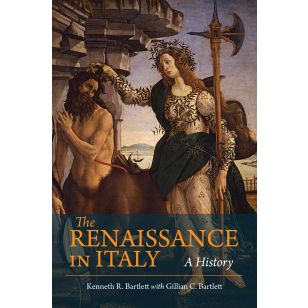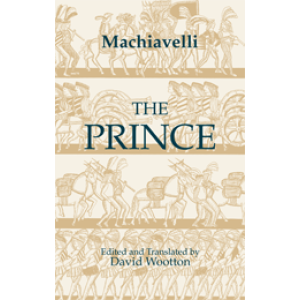The Renaissance in Italy: A History
"An elegant tour of the republics and princely courts where the Italian Renaissance flourished. Bartlett presents a survey of glittering cultural, literary, and artistic achievements, never losing sight of the important political contexts in which they were made. The whole sweep of the Italian Renaissance—the fabulous wealth of its merchants, the ruthless schemes of its princes, the high ideals of its poets and writers, the astonishing works of its artists and architects, the struggles of its visionaries and reformers—comes into focus." —Margaret Meserve, University of Notre Dame
"Kenneth Bartlett (Univ. of Toronto, Canada), a prolific writer on Italy, the Renaissance, and humanism, and Gillian Bartlett, an author and educator, have produced a volume that will appeal to many scholars. Their book is organized as a series of biographies of prominent figures from the period—including Petrarch, Machiavelli, and Michelangelo, among others—and each chapter concludes with examples of appropriate works of art, accompanied by useful commentaries. The authors begin with Petrarch, describing how he introduced and popularized concepts that defined humanism. Geographically, Bartlett and Bartlett also focus more on minor states, such as Naples, than is customary, although they ultimately chart their narrative to Counter-Reformation Rome, where humanism died, leaving its traces in art and architecture. Happily, the spirit of humanism also survived elsewhere, to enrich our lives today. . . . [T]hose with some background knowledge will be fascinated by this beautifully written text, and will hopefully appreciate the poetic rhythm of the prose, appropriate for a book that celebrates Cicero, the ultimate Latin stylist. Summing Up: Highly recommended. All readership levels." —W. L. Urban, emeritus, Monmouth College (IL), in Choice
The Italian Renaissance has come to occupy an almost mythical place in the popular imagination. The outsized reputations of the best-known figures from the period—Michelangelo, Niccolo Machiavelli, Lorenzo the Magnificent, Pope Julius II, Isabella d'Este, and so many others—engender a kind of wonder. How could so many geniuses or exceptional characters be produced by one small territory near the extreme south of Europe at a moment when much of the rest of the continent still labored under the restrictions of the Middle Ages? How did so many of the driving principles behind Western civilization emerge during this period—and how were they defined and developed? And why is it that geniuses such as Leonardo, Raphael, Petrarch, Brunelleschi, Bramante, and Palladio all sustain their towering authority to this day?
To answer these questions, Kenneth Bartlett delves into the lives and works of the artists, patrons, and intellectuals—the privileged, educated, influential elites—who created a rarefied world of power, money, and sophisticated talent in which individual curiosity and skill were prized above all else. The result is a dynamic, highly readable, copiously illustrated history of the Renaissance in Italy—and of the artists that gave birth to some of the most enduring ideas and artifacts of Western civilization.
Reviews:
"An elegant tour of the republics and princely courts where the Italian Renaissance flourished. Bartlett presents a survey of glittering cultural, literary, and artistic achievements, never losing sight of the important political contexts in which they were made. The whole sweep of the Italian Renaissance—the fabulous wealth of its merchants, the ruthless schemes of its princes, the high ideals of its poets and writers, the astonishing works of its artists and architects, the struggles of its visionaries and reformers—comes into focus."
—Margaret Meserve, University of Notre Dame
"Kenneth Bartlett, a prolific writer on Italy, the Renaissance, and humanism, and Gillian Bartlett, an author and educator, have produced a volume that will appeal to many scholars. Their book is organized as a series of biographies of prominent figures from the period—including Petrarch, Machiavelli, and Michelangelo, among others—and each chapter concludes with examples of appropriate works of art, accompanied by useful commentaries. The authors begin with Petrarch, describing how he introduced and popularized concepts that defined humanism. Geographically, Bartlett and Bartlett also focus more on minor states, such as Naples, than is customary, although they ultimately chart their narrative to Counter-Reformation Rome, where humanism died, leaving its traces in art and architecture. Happily, the spirit of humanism also survived elsewhere, to enrich our lives today. . . . [T]hose with some background knowledge will be fascinated by this beautifully written text, and will hopefully appreciate the poetic rhythm of the prose, appropriate for a book that celebrates Cicero, the ultimate Latin stylist. Summing up: Highly recommended. All readership levels."
—W. L. Urban, emeritus, Monmouth College (IL), in Choice
"Bartlett looks at the Renaissance in a new and original way. Instead of tracing a history of the Renaissance in Italy, as do most of the studies available today, Bartlett's book is focused on key people and city states, from Petrarch and his era to the 'End of the Renaissance in Rome,' during the pontificate of Pope Sixtus V from 1585 to 1590. The twenty-two chapters are exhaustive and provide an excellent and novel view of the Italian Renaissance. This book is well thought out, clearly developed, and beautifully written. I recommend it to anyone interested in the culture of one of the most interesting periods of early modern European history."
—Massimo Ciavolella, University of California, Los Angeles
"From a pedagogical standpoint, The Renaissance in Italy is an extremely effective introduction to the politics, thought, culture, and production of early modern Italy. The book could easily serve as a foundational text for an undergraduate history elective on the Italian Renaissance; its frequent use of images and quotations from primary sources make the text extremely readable. Likewise, the book’s chapters could easily be excerpted for an introduction to the Renaissance within the context of a larger European civilization core or survey course. The first two parts in particular, on humanism and Florence, seem written with a direct eye towards providing a generalist audience with a comprehensive yet understandable introduction to the period. The Bartletts’ writing style is engaging and, most importantly, narrativized. . . . The Renaissance in Italy is an exceptional beginner’s introduction to the Italian Renaissance, suitable for the particular pedagogical challenges facing teachers of early modern Italy. . . . [I]t clearly succeeds in what I take to be its primary goal: to get those who have a cursory knowledge of the Italian Renaissance to care about the period and to instill in those newcomers a passion to learn more—a very worthy goal, well-achieved."
—John-Paul Heil, in Studies in Medieval and Renaissance Teaching (SMART)
"A lively study informed by the latest international scholarship. Building on his years of experience as a teacher and a guide for travelers to Italy, Bartlett has created a well-written and up-to-date history of the high culture of the period, 'an exploration of the Italian Renaissance guided by particular moments and men—and a few remarkable women.' Bartlett shows how the unique artistic and cultural flowering of the Renaissance fit with the interests and outlooks of the elites who dominated the various Italian cities. His case studies range well beyond the usual Florentine and Roman experiences to include many of the smaller, but equally exciting, courts of northern and central Italy. The studies themselves are freestanding and could easily be used by travelers as introductions to these various cities."
—Duane Osheim, The University of Virginia
"Bartlett has pulled together an enormous amount of historical documentation and illumination into a small book, including a tasty selection of source documents and an indispensable glossary. The writing is artfully compact and efficient, not sacrificing a copious amount of detail that discreetly illustrates this colorful story. The book would be ideal for a survey course, students of Florentine history, or anyone wanting a good explanation of complicated issues during this period of enormous artistic expression. It is also recommended for students of political history for its insight into the dynamics of how a people struggle for liberty against existing powers. It would be fair to say that this book may even shed light on some of the current struggles for democracy, given its broad theme of the distribution of wealth and power."
—David R. Bass, in Sixteenth Century Journal
"Kenneth R. Bartlett and Gillian C. Bartlett have produced an original and elegant history of the Renaissance in Italy by concentrating on significant figures and city states from the time of Petrarch to that of Pope Sixtus V. The structure of the book is clear and illuminating. The five parts and twenty-two chapters are informative and allow some depth; they are focused and not the usual survey."
—Jonathan Locke Hart, Shandong University, in Renaissance and Reformation
"Kenneth Bartlett and Gillian Bartlett have executed a fine accomplishment. They have gathered together an enormous amount of history into a volume of 364 pages, including a tasty selection of source documents, and an extensive bibliography and index. The writing is elegantly compact without sacrificing style or clarity and carries the Renaissance narrative with color and interest while not omitting essential detail. This book would be ideally recommended as a text for a survey course of Italian, especially Florentine, history, or to any reader seeking to understand the complicated issues of a complicated period of seminal artistic expression and unprecedented political clashes."
—David R. Bass, in Sixteenth Century Journal
About the Authors:
Kenneth Bartlett is Professor of History and Renaissance Studies at Victoria College, University of Toronto. He is the author, editor, or translator of seven books, including, most recently, Florence in the Age of the Medici and Savonarola, 1464-1498 (Hackett, 2018). Ken has also produced five video series: The Italian Renaissance; The Italians Before Italy; The Development of European Civilization; Discovering Medieval Europe; and The Smithsonian/Great Courses Guide to Essential Italy.
A celebrated educator, he has been awarded the Victoria University Excellence in Teaching Award, the Students' Administrative Council Teaching Award, the Faculty of Arts and Science Outstanding Teaching Award, the President’s Teaching Award, the Ontario government LIFT award and, in 2005, the prestigious 3M National Teaching Fellowship.
Gillian Bartlett received her PhD in Educational Theory from the University of Toronto in 1989. Her teaching career has ranged from high school to post-graduate adult education at institutions as varied as the National Ballet School, the University of Toronto Schools (UTS), Seneca College, and the School of Continuing Studies at UofT. In 2014 Gillian was awarded the University of Toronto School of Continuing Studies outstanding Teaching Award.
Among numerous other books, Gillian is the author of all three volumes of McGraw Hill's Writing Power series; she has also contributed material to a number of language education texts. She has served as editor and script consultant for Ken's Great Courses series on the Italian Renaissance and Western Europe as well as for the premier virtual reality tour of Venice produced by Oculus.













